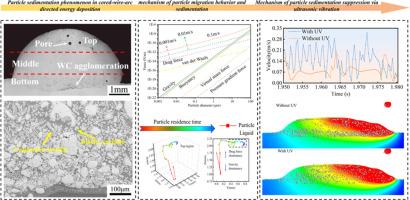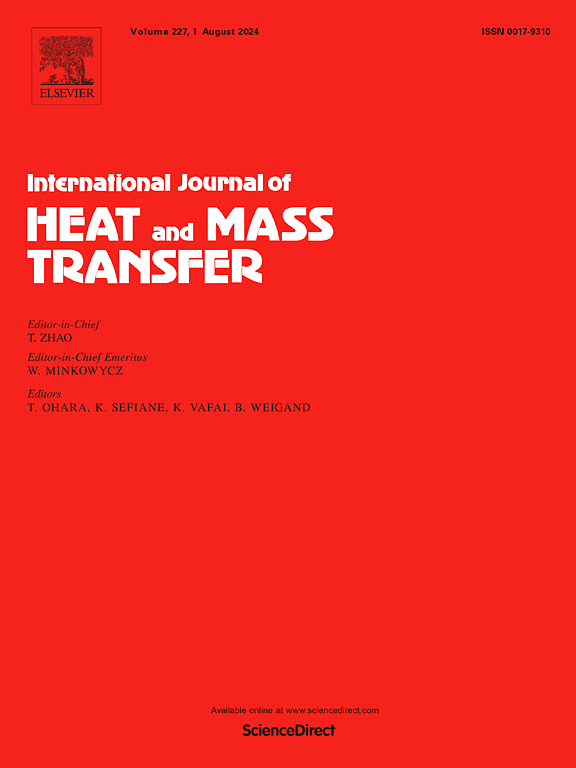Particle sedimentation in cored-wire-arc directed energy deposition: Particle migration and suppression mechanism via ultrasonic vibration
IF 5
2区 工程技术
Q1 ENGINEERING, MECHANICAL
International Journal of Heat and Mass Transfer
Pub Date : 2024-11-17
DOI:10.1016/j.ijheatmasstransfer.2024.126446
引用次数: 0
Abstract
Cored-wire-arc directed energy deposition (DED), as an emerging manufacturing technology, can achieve multi-material additive manufacturing and satisfy the demand for structural-functional integration. However, high-density particles will sink and aggregate at the bottom of molten pool, which will cause defects such as cracks or porosity, decreasing the bonding between the deposited layers and deteriorating the mechanical properties of the components. Therefore, it is essential to investigate the migration behavior of particles in molten pool and the suppression strategy to improve formation quality. Here, a three-dimensional numerical model is developed to reveal the molten pool dynamics and particles migration mechanism during cored-wire-arc DED. The influence of molten droplets impingement and molten pool flow on particles migration behavior in the additive manufacturing process is investigated. Furthermore, the effect regulation of relative velocity between particle and molten pool on particles migration behavior is analyzed mechanistically, which reveals the sedimentation mechanism of the particles. Results demonstrate that molten pool flow velocity will influence the relative velocity between particles and molten pool, which will decide the acceleration of particles; moreover, the particles will sink while the relative velocity is in the same direction with gravity or the relative velocity is lower. Finally, ultrasonic vibration (UV) is introduced to suppress the sedimentation and aggregation of particles, and the corresponding suppression mechanism is revealed. UV will increase the flow velocity of molten pool, which will suppress the sedimentation and agglomeration of particles, as well as reduce the temperature gradient of molten pool, increasing the depth of penetration. This work provides a foundation for further improving the quality of components fabricated via cored-wire-arc DED.

芯线-电弧定向能量沉积中的粒子沉积:粒子迁移和通过超声波振动的抑制机制
芯线-电弧定向能沉积(DED)作为一种新兴制造技术,可实现多材料增材制造,满足结构-功能一体化的需求。然而,高密度颗粒会在熔池底部下沉和聚集,从而导致裂缝或孔隙等缺陷,降低沉积层之间的结合力,恶化部件的机械性能。因此,研究熔池中颗粒的迁移行为和抑制策略以提高形成质量至关重要。本文建立了一个三维数值模型,以揭示芯线-电弧 DED 过程中的熔池动力学和颗粒迁移机制。研究了增材制造过程中熔滴撞击和熔池流动对颗粒迁移行为的影响。此外,还从机理上分析了颗粒与熔池之间相对速度的调节对颗粒迁移行为的影响,揭示了颗粒的沉降机理。结果表明,熔池流速会影响颗粒与熔池之间的相对速度,从而决定颗粒的加速度;此外,当相对速度与重力方向一致或相对速度较低时,颗粒会下沉。最后,引入超声波振动(UV)来抑制颗粒的沉降和聚集,并揭示了相应的抑制机理。紫外线会增加熔池的流速,从而抑制颗粒的沉积和聚集,并减小熔池的温度梯度,增加熔池的渗透深度。这项工作为进一步提高通过芯线-电弧 DED 制造的部件的质量奠定了基础。
本文章由计算机程序翻译,如有差异,请以英文原文为准。
求助全文
约1分钟内获得全文
求助全文
来源期刊
CiteScore
10.30
自引率
13.50%
发文量
1319
审稿时长
41 days
期刊介绍:
International Journal of Heat and Mass Transfer is the vehicle for the exchange of basic ideas in heat and mass transfer between research workers and engineers throughout the world. It focuses on both analytical and experimental research, with an emphasis on contributions which increase the basic understanding of transfer processes and their application to engineering problems.
Topics include:
-New methods of measuring and/or correlating transport-property data
-Energy engineering
-Environmental applications of heat and/or mass transfer

 求助内容:
求助内容: 应助结果提醒方式:
应助结果提醒方式:


